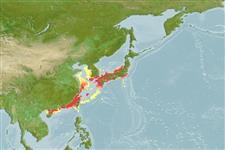Environment: milieu / climate zone / depth range / distribution range
Ecología
marino asociado a arrecife; rango de profundidad 1 - 55 m (Ref. 89707). Tropical; 39°N - 20°N, 109°E - 143°E (Ref. 5222)
Northwest Pacific: southern China, Taiwan, East China Sea, Korea, and southern Japan (Kyushu to about 38°N on both coasts of Honshu). Reported specimen from Viet Nam may be Epinephelus fasciatomaculosus and records from the Philippines and India are unsubstantiated.
Length at first maturity / Tamaño / Peso / Age
Maturity: Lm ?, range 23 - ? cm
Max length : 58.0 cm TL macho / no sexado; (Ref. 89707); common length : 30.0 cm TL macho / no sexado; (Ref. 2852); peso máximo publicado: 2.5 kg (Ref. 40637)
Espinas dorsales (total): 11; Radios blandos dorsales (total): 15-17; Espinas anales 3; Radios blandos anales: 8. Distinguished by the following characteristics: head and body pale brownish grey, covered with small red, orange or gold spots except on ventral side; 6 faint oblique dark bars on body; dark brown blotch on body at base of the 3 dorsal fin spines; dorsal fin margin yellow or orange; row of dusky yellow or orange spots along middle of the spinous dorsal fin and another row along the base of the fin; faint red or orange spots at caudal and anal fins; body depth less than head length, 2.7-3.2 times in SL; head length 2.3-2.6 times in SL; preopercle with enlarged serrae at angle; upper edge of operculum straight; subequal posterior and anterior nostril; maxilla reaching about to vertical at rear edge of eye; two rows of teeth at midside of lower jaw; pelvic fins not reaching anus; caudal fin rounded; lateral body scales ctenoid, with auxiliary in adults (Ref. 089707).
Rock-reef species inhabiting depths to at least 55 m. Juveniles are often found shallower than 10 m (Ref. 089707). A highly prized food fish usually caught by hand-lining over rock strata. Found in Hong Kong live fish markets (Ref. 27253).
Life cycle and mating behavior
Madurez | Reproducción | Puesta | Huevos | Fecundidad | Larva
Heemstra, P.C. and J.E. Randall, 1993. FAO Species Catalogue. Vol. 16. Groupers of the world (family Serranidae, subfamily Epinephelinae). An annotated and illustrated catalogue of the grouper, rockcod, hind, coral grouper and lyretail species known to date. Rome: FAO. FAO Fish. Synop. 125(16):382 p. (Ref. 5222)
IUCN Red List Status (Ref. 130435)
Threat to humans
Harmless
Human uses
Pesquerías: escaso valor comercial; Acuicultura: comercial
Más información
ReferenciasAcuiculturaPerfil de acuiculturaRazasGenéticaElectrophoresesheritabilidadEnfermedadesProcesamientoNutrientsMass conversion
Herramientas
Special reports
Download XML
Fuentes de Internet
Estimates based on models
Preferred temperature (Ref.
123201): 16 - 25.5, mean 20.6 °C (based on 178 cells).
Phylogenetic diversity index (Ref.
82804): PD
50 = 0.5000 [Uniqueness, from 0.5 = low to 2.0 = high].
Bayesian length-weight: a=0.01445 (0.00751 - 0.02781), b=3.06 (2.90 - 3.22), in cm total length, based on LWR estimates for this species & Genus-body shape (Ref.
93245).
Nivel trófico (Ref.
69278): 4.0 ±0.65 se; based on food items.
Resiliencia (Ref.
120179): Medio, población duplicada en un tiempo mínimo de 1.4-4.4 años (Assuming tm=2).
Fishing Vulnerability (Ref.
59153): Moderate vulnerability (43 of 100).
Nutrients (Ref.
124155): Calcium = 25.5 [12.5, 53.6] mg/100g; Iron = 0.46 [0.25, 0.94] mg/100g; Protein = 18.6 [17.1, 20.0] %; Omega3 = 0.12 [0.08, 0.19] g/100g; Selenium = 34.3 [20.5, 60.7] μg/100g; VitaminA = 184 [52, 657] μg/100g; Zinc = 1.24 [0.87, 1.73] mg/100g (wet weight);
